K-ON!
FUNimation To Release Shakugan no Shana Season 1 On Blu-ray This August
TRSI has listed FUNimation’s August release schedule, which includes more of the classic series from the Geneon and ADV libraries. The Shakugan no Shana DVD/Blu-ray combo will be making an appearance. Read more to see the entire list of upcoming goodies. Continue reading
Join the club
Recent years have brought forth a slew of anime about school clubs. K-On! had the light music club, Haruhi had the SOS Brigade, MM! had the Second Voluntary Club, Haganai had the “make friends” club and so on. Most anime viewers in the West take these clubs with a grain of salt. Can such clubs exist in real life Japan or are they fictitious creations meant for the sole purpose of spicing up school life series for our enjoyment?
Well, the short answer is no, the SOS Brigade or the “make friends” club would never be allowed to exist in a real high school.
Why not? First of all, every club needs an advisor – a teacher which is responsible for the safety or the students involved in the club. He/She usually have background in the field of said club and can advise on club activities (hence the name advisor). To form a club in a Japanese high school there are certain rules that must be followed, and securing an advisor is on such rule. So even if there were those with the will to form a “host club”, they will have to find a teacher who is willing to be their advisor. That can be quite a challenging feat considering your club activities consist of entertaining girls, drinking tea and eating cake. In high school, most of the teachers are already involved in one or two permanent clubs (such as the kendo club or the music club) and will not take upon themselves a club which seems inappropriate or absurd.
Second, the number of clubs allowed to operate at the same time is predetermined by the each school, so even if you have an amazing idea for a club and did find a teacher who has the time and will to become your advisor, you might end up in a waiting list for club formation. This basically means your club will be on-hold until another club folds or is deemed inactive.
So yes, your average school anime uses clubs which in reality would not have been approved. There are exceptions of course: anime series usually do a good job when it comes to portraying sport clubs. Furthermore, sub categories of popular clubs (the light music club is a sub category of the music/instrumental club) do exist. And lastly, everything I wrote above does not hold in the case of private schools, in which exclusive clubs might be formed.
 A band inspired by K-On! The subtitles translate to:
A band inspired by K-On! The subtitles translate to:
“I watched the K-On! anime and it looked like good fun so I joined the club”
But wait, I said that the short answer to the question is no. The longer, yet simple, answer is indeed yes – most of these clubs can be formed in real life Japan. But not in high schools. They are made possible in a later time in life, when Japanese students don’t need to worry too much about tests and have exponentially more time on their hands for clubs – their university years. In the university clubs can be formed without the need for an advisor. Moreover university clubs can indulge in much longer and extravagant activities. For example a hiking club, while hard to be found in your average high school, is quite common in Japanese universities. I studied for my Master’s degree in Soka university (located in Tokyo’s Hachioji quarter) and we had tons of these clubs – the ski club, the hiking club, the onsen club (a club for onsen loving folks who want to try onsen in different parts of Japan), the electronic music club, you name it!
I know what you’re thinking: these are all normal clubs. Are there any crazy clubs à la anime series? Yet again the answer is a definitive yes. I was walking on campus one day when I spotted a sign board advertising several new clubs. Among these was “the chocolate lovers’ club”. The informative pamphlet specified it as a club “for chocolate lovers by chocolate lovers. Join us as we sample chocolate from all over Japan and go on expeditions in search of the perfect chocolate delicacy”. Alongside this club was a pamphlet advertising the gourmet club, which worked on a similar premise.
 Three attractive girls and one worthless guy decide to form a chocolate club in their local high
Three attractive girls and one worthless guy decide to form a chocolate club in their local high
school. Each of them works hard to create the perfect chocolate with the dream that one day
they can give it to their secret love as a present. In the final episode it turns out all the attractive
girls were madly in love with the worthless guy and give him their chocolate hearts. The series
will be called Chocolate Club Craze, but after the first episode everyone will refer to it as CCC.
I usually ate my lunch at about 3:30 pm, but one day I finished early and arrived at the cafeteria at around two o’clock. I was surprised to find that several people had connected some tables around the (seldom used) TV monitor and were watching a drama series. I walked in and curiously asked as to what they were doing. It turned out they were the self-proclaimed “drama watching club”. They formed the club to watch their regular drama series, which always aired on the same hour they took their lunch break. Creating the drama watching club didn’t garner them any special rights, except maybe the right the use the TV itself. It was more like an alliance of like-minded drama fans who spent the rest of their day studying at their respective faculties. And that’s exactly the difference between high school clubs and university clubs. Sure, you can join the Karate club even in the university and you will most likely be greeted by Karate experts with years of experience under their 3rd Dan Karate belt. But you can also try to indulge in your personal hobbies and create a less formal club of like-minded folks. The bottom line is this: clubs in Japan, just like any other country, are created to serve as a framework for like-minded people. Be it the Judo club, or the “we Love Plus club”.
Bandai Entertainment USA Folds
What a bad way to start 2012! As you might have heard by now Bandai Entertainment, the U.S. based subsidiary of Namco Bandai Japan, will stop releasing new titles in February. That includes all of the companies’ manga and anime line. According to the ANN’s article:
“Bandai Entertainment will focus on licensing rights to other companies, particularly in digital distribution, broadcast, and merchandising.”
This in fact translates to “Bandai Entertainment will close its offices, but a representative will be kept in the U.S. in case any of the other U.S. based anime distribution companies wants to license a series directly from our Japanese firm.”
All the series Bandai Entertainment already released will remain in print for now, so there’s no need to panic even if you managed to miss one of Bandai’s releases along the way. But Bandai’s statement that it will stop releasing new titles is a bit enigmatic. Licensed series which have not been published yet are one thing, but what about series Bandai has been churning out in earnest, but haven’t been fully released yet? Will Bandai ever finish releasing Tales of the Abyss? and what about the second season of the very popular K-ON? These are series which were released in tiny little bits instead of a fully fledged complete series box set, and Bandai should be ashamed for not finishing them yet.
Then again, herein lies the problem: Bandai Entertainment’s current “restructuring” misfortune is the end-result the Bandai’s own inability to market its products. Back in the 90s it was common to release series in singles, with each single containing 2-7 episodes, and sell it at a premium price. ADV, Geneon, Media Blasters, Bandai, all the big distribution companies did this. But this marketing style began to lose steam in the new millennium, and eventually brought ADV and Geneo to their knees. In a recent ANNCast interview Bandai Entertainment’s former marketing manager for Jerry Chu told Zac Bertschy and Justin Sevakis that Bandai Entertainment USA succeeded where ADV and Geneon failed because it really did offer a premium package to those who bought those premium priced singles and box sets. However, what might have been true for the beginning of the millennium can become irrelevant in a few years’ time. Bandai continued to release overpriced singles in a new age where no other publisher dared to do so. Aside from the obviously exaggerated price tags (20$ for 4 episodes of K-ON after a discount? really?) the notion of having to wait a year or two for the series you like to be published bit by bit has become archaic. Other companies have often released series in two parts, but slicing a series to more than 2 parts (unless it is a long-running series) is in bad taste.
Bandai has been making bad marketing choices for years. One example would be the companies obsession with Gundam. Bandai released Gundam-related series left and right, never bothering to stop and check which Gundam series had actual potential for success and which is was garbage. But perhaps Bandai’s most recent infamous failure is its inability to market Gurren Lagann. Gurren Lagann had the potential to become a cult hit. It should have been the next Full Metal Alchemist/Naruto/DBZ (you get the point). But Bandai didn’t promote it properly, released it as over-priced singles, and only sold it through its own online store (which is now closed). Frankly, the sleepy Bandai desperately needed a heavy hitter like Gurren Lagann. Instead that great title had undeservingly mediocre sales and didn’t create any sort of hype. Bandai continued to release singles until the bitter end. I feel sorry for all those who bought the three Tales of the Abyss DVD boxes and are now nervously worried if the forth (final) DVD box for the series will ever be released.
But enough about that. Grudges aside, Bandai Entertainment also managed to release mighty good anime while it lasted. I personally want to thank the company for releasing .hack//Sign, Lucky Star and The Girl Who Leapt Throught Time. May Bandai Entertainment rest in peace.



















